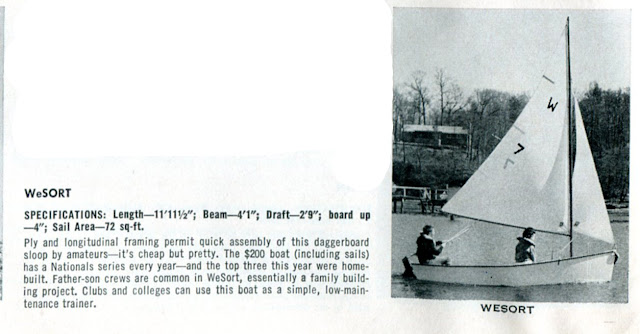Michael Storer mentioned in his history of the Oz Goose box boat that the ongoing group building effort in the Philippines became a key contributor to getting a good size fleet of Oz Goose's going in an area not known to be a yachting center. This reminded me how community group building in the 1960's (particularly in the U.S.A) played a huge role in the emerging popularity of the small sailing dinghy. All sorts of local chined plywood classes, Dusters, Rhode Bantams, El Toros ... were built over the winter, by groups of mostly Dad's, led by one or two experienced woodworkers, the rest following along. Usually ten or so dinghies with all the sailing bits and pieces were banged out, the hulls chosen by lot to be taken home to be painted and fitted out. This was before stitch and glue construction so most construction required a mold, which would be taken out of storage the next winter for a different group. Several winters of building would give a large and active fleet for summer training and racing.
Below is an article by Ed Perry from a 1964 issue of One-Design and Offshore Yachtsman about a community group build of the Blue Jay, the 13 foot Sparkman and Stephens junior trainer. Use the pop-out icon in the top-right to put the article in another tab on the browser for easier reading.
The 12' We-sort, a jaunty, flat-bottom, plywood skiff with sloop rig, was our local 1960's class. The We-sort was group built in the various communities that border the Severn River, just above Annapolis. It came out of the Indian Landing Boat Club that sat at the headwaters of the Severn River.
"Will Jacobs, caretaker of the Indian Landing Boat Club property for many years had several rowboats he rented out to locals. His boats rowed easily and were simple to build. The form had been worked up by Willie’s ancestors, Algonquin Indians, who were also responsible for the name of the area. The Indian tribe referred to themselves as We-Sorts and everyone else as They-Sorts. It seemed fitting to name the sailing/rowing skiff the We-Sort. Led by William Sands, who drew up the plans and added the sailing bits, the sailboats were built by club members in basements, garages, and in some cases living rooms. The We-Sort was a perfect fit for youngsters. It was very stable, which made the young sailors comfortable to be out on the water. By 1961, thirteen of he We-Sorts had been built."The one-page informational blurb on the We-sort:
Tom Price, artist, learned to sail in a We-sort and drew this pencil sketch of a racing group going upwind.
Tom Price, pencil
Alan Dove has put up a couple of posts about the We-sort and I have pulled the following photos from his site.
Dennis Buckley
Dennis Buckley
From the One-Design and Offshore Yachtsman, January, 1967 class review guide:
CBMM, Chesapeake Maritime Museum over at St. Michaels, did a group build of We-sort's. They used the fleet for a summer training program for a couple of years but I think they now only have plastic boats for sail training.
Addendum: Pete Lesher, chief curator, fills us in on the history of the We-sorts at the Chesapeake Bay Maritime Museum. (Pulled from the comments.)
"Chesapeake Bay Maritime Museum's fleet of 6 We-Sorts was constructed in the late 1980s after We-Sort #2, Wee Lass, was donated to the museum. They were used for 15 years or so in the museum's summer sailing camp. At one point, a couple of the hulls were damaged in a fire in off-season storage, and at least two replacement hulls were built. When the We-Sorts were worn out from hard use, the museum considered a replacement fleet, but the sailing instructor at the time led the museum to instead acquire a fleet of plastic JY-15s. Some of the We-Sorts were sold, but one or two still remain, their rigs long gone, as rowing craft in the museum's summer boat livery. The youth sailing camp has been discontinued."
Wesort dinghy, WeSort skiff.





4 comments:
Chesapeake Bay Maritime Museum's fleet of 6 We-Sorts was constructed in the late 1980s after We-Sort #2, Wee Lass, was donated to the museum. They were used for 15 years or so in the museum's summer sailing camp. At one point, a couple of the hulls were damaged in a fire in off-season storage, and at least two replacement hulls were built. When the We-Sorts were worn out from hard use, the museum considered a replacement fleet, but the sailing instructor at the time led the museum to instead acquire a fleet of plastic JY-15s. Some of the We-Sorts were sold, but one or two still remain, their rigs long gone, as rowing craft in the museum's summer boat livery. The youth sailing camp has been discontinued.
Thanks Pete! I've pulled your comment over to the main post. Do you know of any other small sailboat group building in the sailing history of the Chesapeake?
I just read the article on the turkey barn boat build, it's incredible to think that a group of people could pull together like that, do the hand's on work and build all of those boats. There was a similar Penguin build in Sea Cliff, NY where I grew up. I don't imagine anything like that ever happening again, I suppose the root cause is having too much money to bother. Times certainly have changed.
John,
Thanks. I'm sure there are plenty of other stories of group builds. Maybe I'll put up a post on Sailing Anarchy and see if anyone else has a story to tell.
Post a Comment